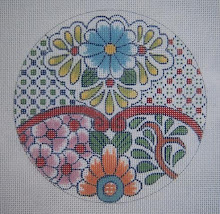 It's strange what falls out of old files when I'm looking for something I did years and years ago. This scan of a photograph dates back about 12 years to when I was busy "interpreting" nature with silk ribbon embroidery.
It's strange what falls out of old files when I'm looking for something I did years and years ago. This scan of a photograph dates back about 12 years to when I was busy "interpreting" nature with silk ribbon embroidery.I had been painting accessories for the National Wildflower Research Center (Lady Bird Johnson's finest achievement), and had hundreds of photos I had taken during different seasons. Great pictures to work from when designing needlepoint.
Anyway, this egg is gone - I have no idea what happened to it, but I apparently photographed the canvas before it went to the finisher. The bluebonnets have the little touches of magenta that one sees on the flower - did you know that bluebonnets are actually quite purple? I had no idea, and I'm a native, until I started mixing paint, using real flowers to get the color right. Incredible! They look so blue en masse out in the field. The little red flowers are Drummond's Phlox, which the Wildflower Center had planted in a bed full of bluebonnets - and the yellow ones are Huisache Daisies.
This was a fun exercise in silk ribbon, as I remember, so think I might try it again. It's already starting to get hot here, but we've had enough rain that the wildflowers out there should be glorious this year. They don't last long, but it's an incredible sight out in the fields. Bluebonnets bloom along with the Indian Paintbrush, (which I never did in silk ribbon). As River Silks hadn't been "invented" yet, on this egg I used Thread Gatherer overdyed ribbon for the foliage, and YLI ribbon for the flowers.
While things are still blooming in the early spring - do go outside and walk and really SEE the leaves and flowers, and think how you might do them on needlepoint in Silk Ribbon!


























